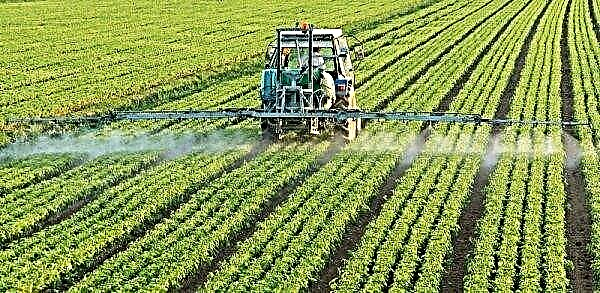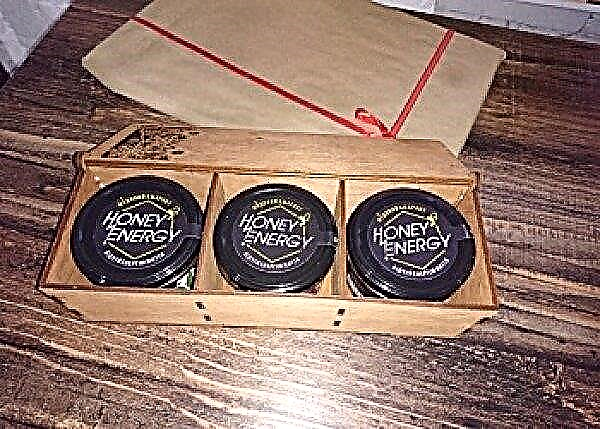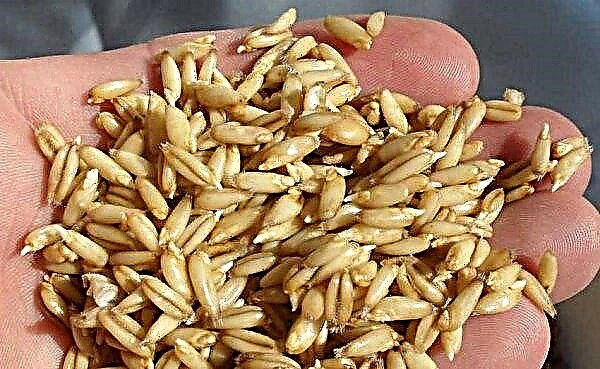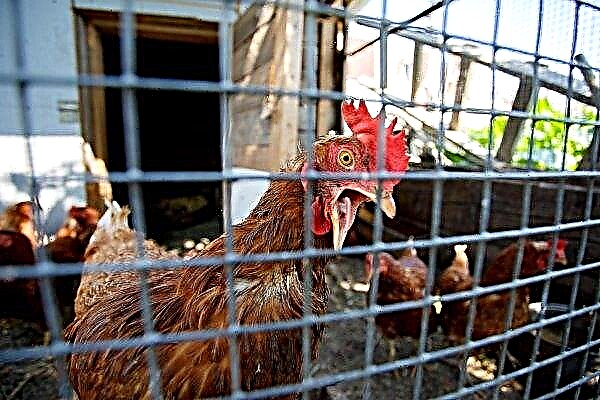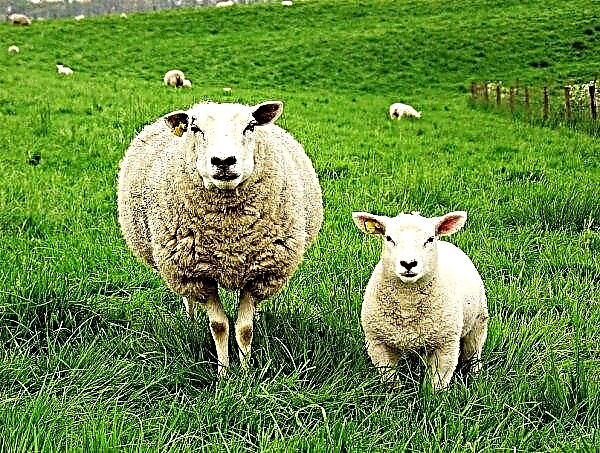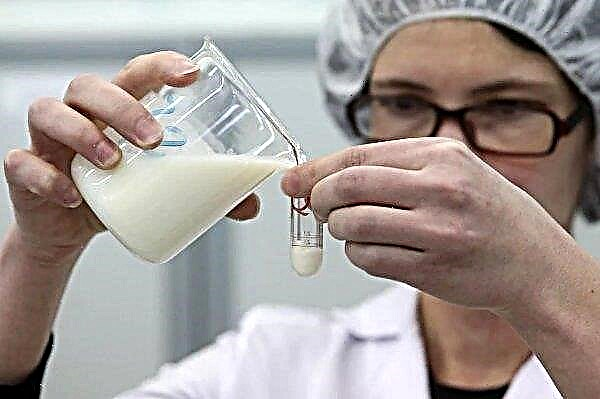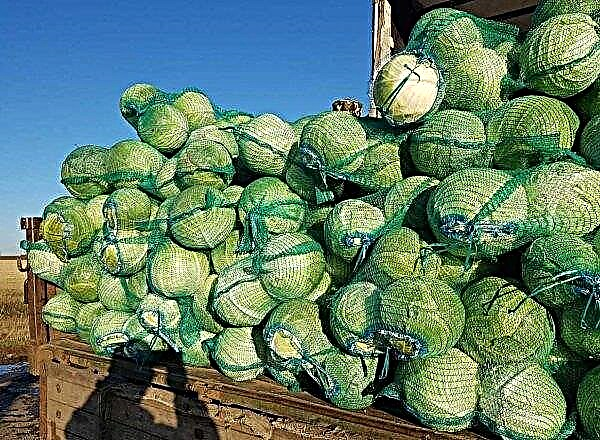In the world there are about 10 thousand varieties of tomatoes that differ in shape, size, color. But the main criterion for the consumer is taste. And here the Raspberry jingle variety has no equal.
Grade description
Raspberry jingle belongs to hybrid varieties and was registered in Russia in 2009. Thanks to the excellent work of breeders, he very successfully combines excellent taste and attractive appearance. The variety is determinant - the bush grows no higher than 1.1 m. Usually 3 stems are formed on it, each of which can have up to 7 brushes. each of which has 5–8 fruits.
Did you know? The largest tomato in the world was grown in America: it weighed 2.9 kg. And the smallest tomatoes are in Israel. They are like blueberries in size.
The bush is quite powerful, with a strong root system. The leaves have a familiar shape for tomatoes and dark green in color, medium in size and without edges.
- The clear benefits of the variety include:
- high productivity;
- attractive appearance;
- thin peel;
- excellent taste;
- good transportability;
- precocity
- resistance to late blight.
Among the shortcomings, one can note only the impossibility to grow seedlings from seeds, as well as the fact that this variety is not used for canning as a whole. Of the many other varieties, Raspberry ringing is distinguished by the absence of a green spot near the stem, i.e., the fruits ripen completely.
Fruit characterization and yield
The fruit of this variety is very attractive in appearance - a rich pink color, an even rounded shape and a glossy peel. The pulp of tomatoes is juicy and sweet, with a pleasant aroma, and the skin is thin. The weight of one tomato reaches 190 g. The fruits develop evenly and practically do not differ in weight from each other (+/– 20 g).
The variety is classified as early ripening - the first crop in the greenhouse can be harvested 85 days after seed germination. In open ground, this is 2-3 weeks later. With proper care from one bush, it is possible to get up to 5 kg of fruits, and from one hundred parts - about 2 tons.
Seedling selection
High-quality seedlings are already half the success in growing Raspberry jingle.
Important! Unnaturally green leaves with curled down edges are a sign that the plant has been overfed with nitrogen fertilizers.
When choosing it, you need to adhere to some rules:
- Plant height should not exceed 25-30 cm. Higher specimens take root worse and can break in the wind.
- The stem should be strong, even, not thinner than the little finger.
- The number of formed leaves is at least 6.
- The leaves and stem must be clean - free from damage, black or brown spots, signs of eating by pests.
- On the reverse side of the sheet should not be eggs of the Colorado potato beetle or other pests.
- Plants should be succulent, not sluggish, and the roots should be in moist soil.

Growing conditions
To grow seedlings, you need to approach responsibly and provide it with certain conditions. In the room where the tanks will be located, it should be warm - not less than + 22 ° С. Humidity is not the main indicator, the main thing is to make sure that the soil on the surface does not dry out. When the seeds have not yet pecked, they do not need light, on the contrary, they keep the boxes in a warm and dark place.
But already growing tomatoes need light, as well as artificial illumination in the evenings. As for the soil, there is a choice - buy ready-made in the store, just for seedlings, or cook it yourself. To do this, it is enough to mix turf soil, sand and peat in equal parts. The soil should be non-acidic, loose and light. Previously, it is disinfected - either with boiling water, or with a solution of potassium permanganate, or by heating in the oven at + 50 ° C.
Preparing and planting seeds
Seeds for planting must first be disinfected in potassium permanganate. The solution is pink, weak. Dip the seeds in it for 30 minutes, then rinse them and soak them in a growth stimulator (for example, you can prepare a honey solution: 1 tsp. In a glass of water). After holding the seeds in the stimulator for about 2 hours, they are dried on paper. Some gardeners still conduct hardening by placing material in the refrigerator. Finished seeds are lowered into moist soil with a toothpick or a manual seeder, 3 cm apart from each other. 0.5 cm of soil is sprinkled on top, moistened with a spray bottle, covered with glass or film and put in a warm place. Be sure to pay attention to the presence of drainage holes in the tank, since seedlings do not like stagnation of water.
Finished seeds are lowered into moist soil with a toothpick or a manual seeder, 3 cm apart from each other. 0.5 cm of soil is sprinkled on top, moistened with a spray bottle, covered with glass or film and put in a warm place. Be sure to pay attention to the presence of drainage holes in the tank, since seedlings do not like stagnation of water.
Important! Leaves, stem and green fruits of tomatoes contain poison — solanine, which is dangerous for the nervous system and digestion, therefore it is better to work with the bushes with gloves and wash your hands well with soap after each contact with greens.
Cultivation and care
When the sprouts appear from the ground and reach 2 cm, the shelter is removed and the containers are transferred to the window. From bright daylight they need to be shaded with a grid or paper. Young plants are watered as the top layer of the earth dries from a syringe. Water should not fall on the leaves. So that they do not grow crooked, it is necessary to turn them to the light in different directions every 2 days. Since the days in spring are still short, plants need extra light. To do this, install special lamps and turn them on for 4 hours after it gets dark on the street.
At the stage of the appearance of two real leaves, seedlings are dived into separate cups. In the case of using peat tablets, this will not have to be done. When the plants are strong and reached a height of 15 cm, you can begin to harden them and prepare for planting in the ground. This usually happens in mid-May. To quench the containers put in the evening on the balcony - first for 30 minutes, increasing the time interval every day. The temperature should not be lower than + 10 ° C. After a week of such hardening, you can accustom young seedlings to the sun, leaving them after 16:00 on the balcony or porch. They also begin with 30 minutes, gradually increasing the time. During the hardening period, seedlings will still grow and reach 20 cm. Now it is time to send it to the garden. On the site Raspberry ringing is located at the rate of 4 bushes per 1 m². After planting, each bush is well watered. Until the plants take root, watering in dry weather is carried out every day, in the evening, at the rate of 0.5 l per plant. Then the tomato does not need frequent watering - enough twice a week, under the root. This variety, like, by the way, all tomatoes, loves loose soil, so cultivation must be done after each watering.
They also begin with 30 minutes, gradually increasing the time. During the hardening period, seedlings will still grow and reach 20 cm. Now it is time to send it to the garden. On the site Raspberry ringing is located at the rate of 4 bushes per 1 m². After planting, each bush is well watered. Until the plants take root, watering in dry weather is carried out every day, in the evening, at the rate of 0.5 l per plant. Then the tomato does not need frequent watering - enough twice a week, under the root. This variety, like, by the way, all tomatoes, loves loose soil, so cultivation must be done after each watering.
Weeding is carried out as the beds are overgrown. To form powerful lateral roots, bushes spud 2 times per season. Since this variety is determinant, it does not need pinching. Garter is only necessary if so many ovaries have formed on the bush that it can fall. In this case, a peg, which is 10 cm higher than the plant, is driven in near the desired bush, and a tomato is tied to it with fasteners or twine.
Did you know? Tomatoes, especially pink ones, contain thiamine - a vitamin for the nervous system, as well as serotonin — hormone of happiness. Thus, tomatoes are a kind of natural antidepressant.
For a good harvest, summer residents use various top dressings. It can be either finished mineral fertilizers, or organic, natural. Using a combination of both fertilizers will be effective: 1 bucket of mullein must be mixed with 9 buckets of water in a large barrel, let it brew for several days and add 20 g of superphosphate. Such top dressing can be applied 2 weeks after the planting of tomatoes in the ground. Next, for the season, 2 more top dressings are carried out with natural means, to choose from:
Next, for the season, 2 more top dressings are carried out with natural means, to choose from:
- infusion of wood ash;
- chicken droppings;
- yeast solution;
- broth of onion peel;
- nettle infusion.
Disease and Pest Prevention
Despite the fact that the breeders tried and made the Raspberry jingle as resistant to diseases as possible, prevention will not be superfluous. It begins in the fall, with the harvesting of all weeds and their burning. Further, the beds are dug up, while adding ash, which will serve as a fertilizer and a disinfector. You can treat the land with insecticides from pests - at this time their larvae hide in the ground and most will die. 3 weeks before planting in the soil, the plants are sprayed with a 0.5% solution of copper sulfate or Bordeaux liquid to avoid infection from other varieties by late blight and other fungi.
When planting, you can also add a handful of onion husks and ash to each well. This will give the plant extra strength. To scare off the Colorado potato beetle and other pests, marigolds and nasturtium are planted around the site and between the bushes. If insects nevertheless attacked the plantings, then insecticides cannot be dispensed with here: they use “Aktara”, “Decis”, “Ratibor”, etc.
Harvesting and storage
The first fruits on the bushes can be picked in mid-July. In summer, while warm nights, tomatoes are harvested as they ripen. Plantings are examined every day and all pink fruits are removed. You should not leave them on the bushes, as they take part of the moisture and nutrients from the tomatoes that have not yet ripened. In the second half of August, when more rain falls and the nights become cool, you can even remove brown tomatoes. They ripen perfectly in a dark, dry place.
Important! Harvesting should only be done in dry weather, waiting for the morning dew to leave.
To extend the shelf life of tomatoes, you need to create special conditions for them. The fruits are laid out in rows in boxes. You can each wrap in soft paper.
Storage temperature depends on maturity:
- ripe stored at +1 ... + 3 ° C;
- brown - up to + 6 ° C;
- green - +10 ... + 12 ° С.
 Periodically, tomatoes are sorted out, spoiled ones are thrown away, and ripe ones are transferred to ripe ones, otherwise they will deteriorate at a higher temperature. Beautiful and delicious Raspberry jingle tomatoes deserve a place in your garden. They are not too demanding to care for, are well transported and rarely suffer from late blight. And their unique taste and aroma cannot be confused with other varieties.
Periodically, tomatoes are sorted out, spoiled ones are thrown away, and ripe ones are transferred to ripe ones, otherwise they will deteriorate at a higher temperature. Beautiful and delicious Raspberry jingle tomatoes deserve a place in your garden. They are not too demanding to care for, are well transported and rarely suffer from late blight. And their unique taste and aroma cannot be confused with other varieties.

